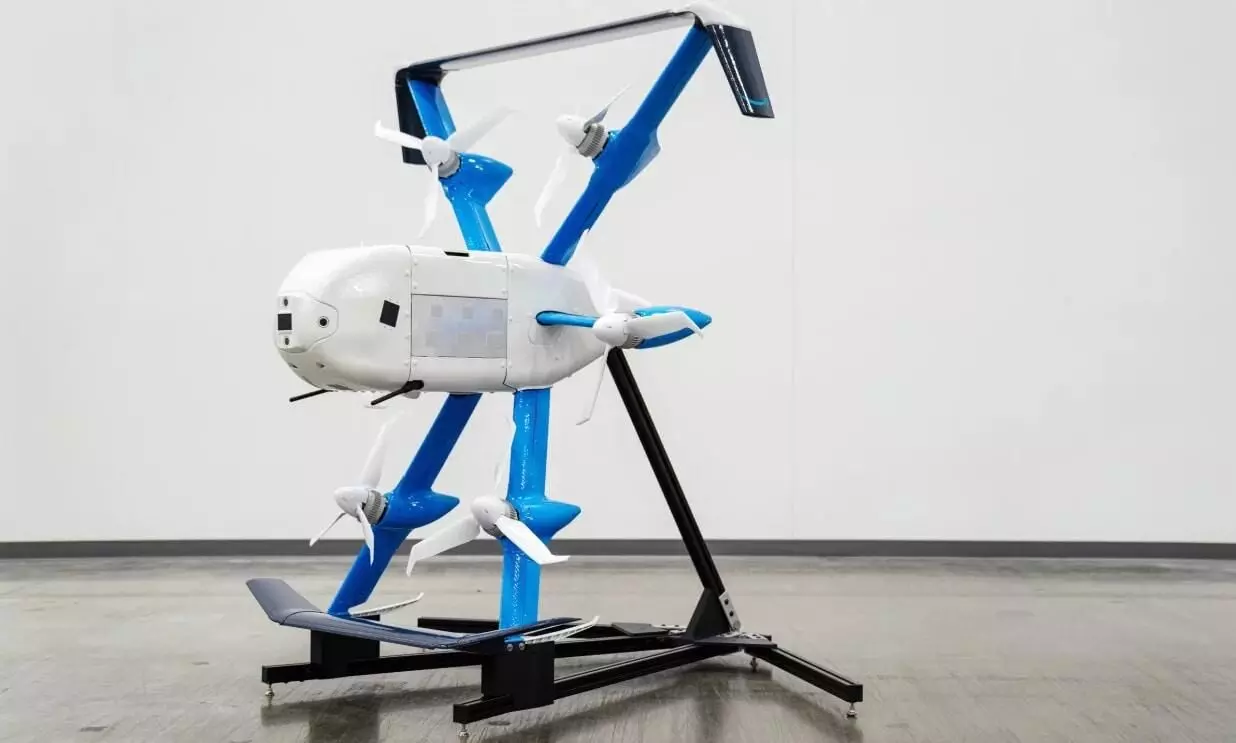
Amazon betting on drones, GenAI for growth
Drones will eventually allow us to deliver packages to customers in less than an hour: Andy Jassy, CEO, Amazon

Amazon’s new MK30 drone
Amazon's delivery drone service (called Prime Air) has the full backing of CEO Andy Jassy, who says drones will eventually allow delivery of packages to customers in less than an hour.
"A service that’s making substantial progress, and we think of as a very valuable future primitive capability — our delivery drones (called Prime Air)," writes Jassy in his 2023 annual letter to shareholders. "Drones will eventually allow us to deliver packages to customers in less than an hour. It won’t start off being available for all sizes of packages and in all locations but we believe it’ll be pervasive over time. Think about how the experience of ordering perishable items changes with sub-one-hour delivery?"
The newest Prime Air drone, the MK30, will replace the drones currently used to deliver in the U.S. by the end of 2024. They will also be deployed in a new, third U.S. state and in soon-to-be-revealed destinations in Italy and the U.K.
Are drones really needed?
So, now here are the questions raised: Both Walmart and Amazon have made highly publicised investments in ramping up their drone delivery capabilities. "Amazon’s new MK30 drone, which will replace its current drones by the end of this year, is lighter and quieter than its current model and can deliver orders within an hour," writes Leticia Miranda in her Bloomberg column.
"Walmart’s drone partnership with Wing and Zipline will reach 1.8 million households across the Dallas-Fort Worth metro area this year and promises to deliver orders within half an hour."
Drones are loud and emit a sound that a 2021 study described as being “substantially more annoying than road traffic or aircraft noise due to special acoustic characteristics such as pure tones and high-frequency broadband noise,” Miranda highlights in her column. "The skies above urban areas are already congested with commercial aircraft and helicopters that have become noisy nuisances for residents.
"A 2023 McKinsey study estimates that a single-package drone delivery costs a company about $13.50, which is more expensive than delivery via an electric or gas vehicle making just one delivery. For drones to make a company money, a single operator will have to manage as many as 20 drones at one time. At that point, a single package delivery will cost about $1.50 to $2, which is cheaper than the cost of an electric car delivering five packages, according to the study. But federal regulations and technology may be quite a ways away from making that a reality.
"Amazon and Walmart’s tech capabilities would be better spent investing in other solutions to speed up online delivery. Both companies have invested in electric vehicles but they still only make up a small fraction of their overall fleets."
Betting on Generative AI
Jassy also wrote about what's next for Amazon after Marketplace, Prime and Amazon Web Services (AWS). "A question people never ask, and might be even more interesting is what’s the next set of primitives you’re building that enables breakthrough customer experiences? If you asked me today, I’d lead with Generative AI (GenAI).
"There are three distinct layers in the GenAI stack, each of which is gigantic, and each of which we’re deeply investing. The bottom layer is for developers and companies wanting to build foundation models (FMs).
"The middle layer is for customers seeking to leverage an existing FM, customise it with their own data, and leverage a leading cloud provider’s security and features to build a GenAI application — all as a managed service.
"The top layer of this stack is the application layer. We’re building a substantial number of GenAI applications across every Amazon consumer business."
Amazon delivery speeds improve
Amazon improved its delivery speeds in 2023 with more than seven billion items arriving the same or next day including more than four billion in the U.S. and more than two billion in Europe.
"In the U.S., this result is the combination of two things," writes Jassy. "One is the benefit of regionalisation where we re-architected the network to store items closer to customers. The other is the expansion of same-day facilities where, in 2023, we increased the number of items delivered same day or overnight by nearly 70 percent year-on-year. As we get items to customers this fast, customers choose Amazon to fulfil their shopping needs more frequently, and we can see the results in various areas including how fast our everyday essentials business is growing (over 20 percent YoY in Q42023)."
Amazon's regionalisation efforts have also trimmed transportation distances, helping lower cost to serve, Jassy added. "In 2023, for the first time since 2018, we reduced our cost to serve on a per unit basis globally. In the U.S. alone, cost to serve was down by more than $0.45 per unit YoY. Decreasing cost to serve allows us both to invest in speed improvements and afford adding more selection at lower average selling prices (ASPs). More selection at lower prices puts us in consideration for more purchases."
There has never been a time in Amazon’s history where we’ve felt there is so much opportunity to make our customers’ lives better and easier. We’re incredibly excited about what’s possible, focused on inventing the future, and look forward to working together to make it so.
-Andy Jassy, CEO, Amazon
Amazon 2023 revenue up 12%
Amazon’s total revenue increased 12 percent to $575 billion in 2023 from $514 billion in 2022. By segment, North America revenue increased 12 percent to $353 billion, international revenue was up 11 percent to $131 billion, and AWS revenue increased 13 percent to $91 billion, Jassy said in his annual letter to shareholders.
"Amazon’s operating income and free cash flow (FCF) dramatically improved. Operating income in 2023 improved 201 percent YoY to $36.9 billion (an operating margin of 6.4 percent). Trailing twelve Month FCF, adjusted for equipment finance leases, improved from -$12.8 billion in 2022 to $35.5 billion in 2023(up $48.3B)."
Internationally, Jassy added that “we like the trajectory of our established countries, and see meaningful progress in our emerging geographies (e.g. India, Brazil, Australia, Mexico, Middle East, Africa, etc.) as they continue to expand selection and features, and move toward profitability (in Q42023, Mexico became our latest international stores locale to turn profitable). We have high conviction that these new geographies will continue to grow and be profitable in the long run.”
Building primitive services
Jassy writes: "Think of them as discrete, foundational building blocks that builders can weave together in whatever combination they desire.
Here’s how Amazon described primitives in the 2003 AWS Vision document: “Primitives are the raw parts or the most foundational-level building blocks for software developers. They’re indivisible (if they can be functionally split into two they must) and they do one thing really well. They’re meant to be used together rather than as solutions in and of themselves. And, we’ll build them for maximum developer flexibility. We won’t put a bunch of constraints on primitives to guard against developers hurting themselves. Rather, we’ll optimise for developer freedom and innovation.”
Pursuing primitives is not a guarantee of success, says Jassy and adds: “There are many you could build, and even more ways to combine them. A good compass is to pick real customer problems you’re trying to solve."
Jassy highlighted the logistics primitives as an instructive example. "In Amazon’s early years, we built core capabilities around warehousing items, and then picking, packing, and shipping them quickly and reliably to customers. As we added third-party sellers to our marketplace, they frequently requested being able to use these same logistics capabilities. Because we’d built this initial set of logistics primitives, we were able to introduce Fulfilment by Amazon (FBA) in 2006, allowing sellers to use Amazon’s fulfilment network to store items, and then have us pick, pack, and ship them to customers with the bonus of these products being available for fast, Prime delivery.
"This service has saved sellers substantial time and money (typically about 70 percent less expensive than doing it themselves), and remains one of our most popular services. As more merchants began to operate their own direct-to-consumer (DTC) websites, many yearned to still use our fulfilment capabilities while also accessing our payments and identity primitives to drive higher order conversion on their own websites (as Prime members have already shared this payment and identity information with Amazon). A couple years ago, we launched Buy with Prime to address this customer need. Prime members can check out quickly on DTC websites like they do on Amazon, and receive fast Prime shipping speeds on Buy with Prime items — increasing order conversion for merchants by ~25 percent vs. their default experience."
Future to build
"There has never been a time in Amazon’s history where we’ve felt there is so much opportunity to make our customers’ lives better and easier," Jassy writes, and concludes his letter by saying: "We’re incredibly excited about what’s possible, focused on inventing the future, and look forward to working together to make it so."

